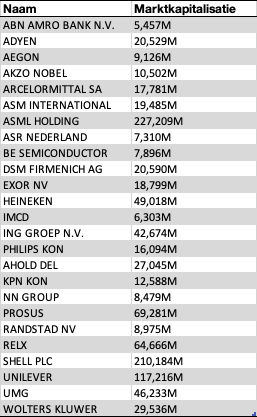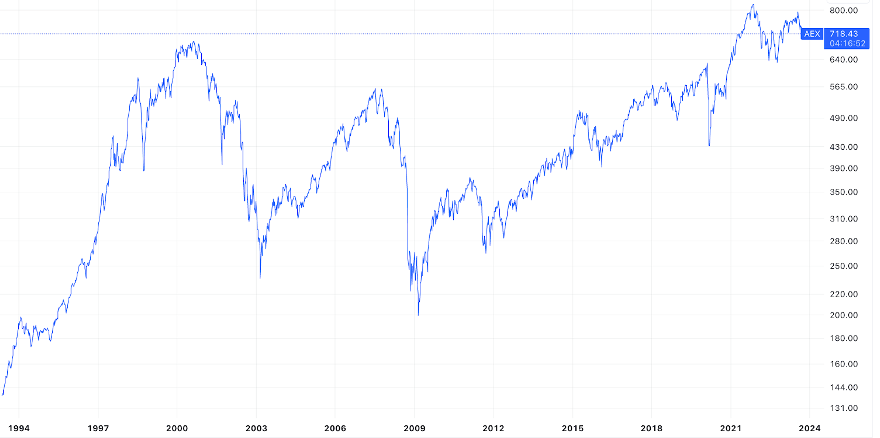For the Dutch version, click here. They are two companies you don't often think about, but they are essential to your daily life. Every time you

For the Dutch version, click here.
The AEX index is considered the main indicator of the Dutch economy. Many newspapers report daily on the state of this index. But what exactly is the AEX index and what does it consist of? Does this index have any effect on the Dutch economy? This article explains.
Foundation
On March 4, 1983, the European Options Exchange (EOE) was established. This name comes from the fact that this index was created to stimulate options trading in the Netherlands. The idea for options trading had come over from America. In this country, the well-known Dow Jones and S&P500 had already existed for some time. In the Netherlands people also wanted to be able to trade in an index of their own country in this way. The index started with 13 companies. In 1990 this was expanded to 25 and in 1994 the name was changed to the now familiar AEX. Some well-known companies that were in this index from the beginning include Ahold, Unilever, Shell and Heineken.
Outside the AEX, there are also Dutch indices for medium and smaller listed companies. These are called the AMX and AsCX. These indices both also consist of 25 companies.
How is the AEX composed
The Amsterdam Exchange Index (AEX) is composed of the shares of the 25 largest and most liquid listed companies on the Dutch stock exchange. These companies are selected on the basis of market value and liquidity. The AEX index is calculated based on the market value of the freely tradable shares of these companies. Here are some key features of the construction of the AEX Index:
Selection of Companies: The selection of companies to be included in the AEX is carried out by Euronext Amsterdam, the operator of the Dutch stock exchange. This selection is based on the market value of the companies’ freely tradable shares. The 25 largest companies based on market value are selected.
Weighting: Each company included in the AEX contributes to the weighting of the index based on the market value of its freely tradable shares. Larger companies therefore have a greater impact on the performance of the index.
Adjustments: The composition of the AEX index may be revised periodically. Companies can be added or removed based on changes in market value, liquidity and other factors.
Base level: The AEX index is calculated at a base level of 100 points. This means that the value of the index was set at 100 points on its founding date (March 4, 1983), and all subsequent fluctuations in value are measured relative to this base value.
Diversification: The AEX index is designed to represent a broad cross-section of the Dutch stock market. The selected companies come from various sectors, including finance, technology, consumer goods, energy and health care.

AEX holdings and market capitalization (Euronext 26-10-2023)
Current companies in AEX
Today, the index consists of the companies shown in the table to the right. The market capitalization shows the weighting of the shares. It can be seen that ASML, Shell and Unilever have the largest weighting within the index. The only Dutch companies that were still in the index when it was created in 1984 are: Ahold, ABN Amro, Shell, Heineken , NN and Unilever. Over the years, the index did change considerably. For example, the technology sector has become increasingly prominent with companies such as Adyen and ASML. The index has also become less and less Dutch. To be added to the index, you only need a listing on the Dutch stock exchange and a large enough market capitalization. As a result, in recent years American UMG and Italian Exor, among others, have been added to the index. Companies that are still seen as truly Dutch are also less and less Dutch than they used to be, because as companies grow, more and more of their turnover comes from abroad.
Return AEX index
The AEX index has experienced several highs and lows over the years, with significant economic events, such as the dotcom bubble around the year 2000 and the 2008 financial crisis, having a major impact on the performance of the index. After these crashes, the index did gradually go back up. The worst year for the AEX was 2008. The return in this year was -52.32%. By contrast, the best year (1988) had a return of 51.12%. Annually, the return of the AEX since inception is 7.05%. Over the past 5 years, it has been 5.81%. These are the returns as of the end of September 2023. The chart below shows the index’s price performance since 1994.

Price movement AEX since 1994
Because the index is concentrated in a few companies, there are companies that add the most return to the index. Within the AEX this is ASML, this was due to the company’s relatively large weighting and the large positive price movement it saw in recent years.
Just because the AEX has performed well over its history does not necessarily mean that this index is a good investment. This is because the index invests in only 25 companies and thus has little diversification. Also, the index is concentrated in a few specific sectors.
For the proud Dutch investor, the AEX is still an index in which many traditionally Dutch companies can be invested in. The companies are just less Dutch than they used to be.
Sources
AEX-INDEX | NL0000000107 | Euronext Exchange Live Quotes. (z.d.). https://live.euronext.com/en/product/indices/NL0000000107-XAMS/market-information
Axento Vermogensbeheer. (z.d.). Historische ontwikkeling van de AEX. Axento. https://axento.nl/beleggen/waarin/aex/historische-ontwikkeling-van-de-aex/#:~:text=Het%20ontstaan%20van%20de%20AEX,opties%20was%20overgewaaid%20uit%20Amerika.
Blekemolen, J. (2023, 19 september). AEX Index: Betekenis, geschiedenis en samenstelling uitgelegd. Online broker LYNX. https://www.lynx.nl/beurs/beurs-koersen/beursinfo/beurs-nieuws-tips/aex-index-samenstelling-weging-aandelen/
Geurtjens, J. (2023, 14 augustus). Gemiddeld rendement AEX op basis van historische data. Finansjaal. https://finansjaal.nl/gemiddeld-rendement-aex/
Snurer, I. (2020, 13 maart). 30 jaar AEX. Beleggers Belangen. https://www.beleggersbelangen.nl/2013/01/02/30-jaar-aex/
Thomas. (2023, 14 april). De grootste 25 AEX bedrijven, welke zijn dit? – Beleggingsinstituut. Beleggingsinstituut. https://www.beleggingsinstituut.nl/beleggers-kennisbank/aex-bedrijven/
VEB – Beursfondsen niet trots op Nederlands. (z.d.). VEB. https://www.veb.net/artikel/01446/beursfondsen-niet-trots-op-nederlands





















